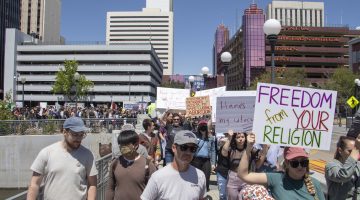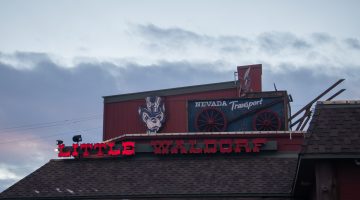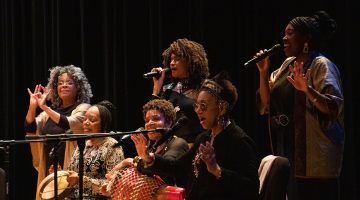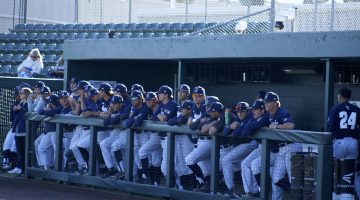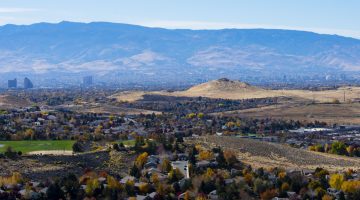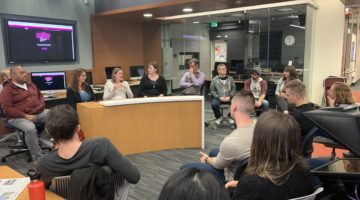
Karolina Rivas/Nevada Sagebrush — A woman chants during a protest outside of an appearance of President Donald Trump at the Reno-Sparks Convention Center on Wednesday, August 23. Trump came to Reno to address the national convention for the American Legion, a non-partisan veterans group.
President Donald J. Trump gave a short, subdued speech before several thousand members of the American Legion — a non-partisan veterans organization — at the group’s national convention Wednesday, Aug. 23, at the Reno-Sparks Convention Center.
Trump’s speech, which seemed to rarely veer from the teleprompter if at all, called for national unity and proved to be a stark contrast to defensive, off-the-cuff and sometimes rambling remarks delivered at an Arizona campaign rally just the day before.
Playing to the military crowd, Trump began with a focus on veterans affairs, praising VA Secretary David Shulkin as a “true reformer,” listing various veteran-related accomplishments of the fledgeling Trump administration, and generally praising the work of the American Legion and its members.
“We are here to draw inspiration from you as we seek to renew the bonds of loyalty that bind us together as one people and one nation,” Trump said. “Those who wear the nation’s uniform come from all different backgrounds and every single walk of life. They are all united by shared values and a shared sense of duty.”
Specifically, the president mentioned two pieces of legislation. First was the Harry W. Colmery Veterans Educational Assistance Act of 2017, also known as the Forever G.I. Bill. The law, among other things, removes the 15-year limit on the education benefits provided by the G.I. bill. It was signed into law by Trump just last week.
Second was the Veterans Appeals Improvement and Modernization Act, which Trump signed after he finished speaking. The bill aims to streamline the way the VA provides care and care updates to the veterans served by it.
Trump went on to discuss the military more generally, briefly touching on U.S. missile defense, the newly minted U.S. strategy for the ongoing war in Afghanistan, and the war against the Islamic State in Iraq. He would eventually pivot to more general pillars of his policy agenda, including infrastructure and law enforcement, before moving back to national unity to close out the 23-minute-long speech.
“It is time to heal the wounds that divide us and to seek a new unity based on the common values that unite us,” Trump said. “We are one people with one home and one great flag.”

Karolina Rivas/Nevada Sagebrush — A Reno police officer speaks to a demonstrator during a protest outside the Reno-Sparks Convention Center on Wednesday, August 23. Around 500 anti-Trump protesters and 25 pro-Trump demonstrators turned out during Trump’s short visit to Reno.
A CONTRAST TO PHOENIX
Trump’s Reno visit followed a contentious campaign-style rally in Phoenix, Arizona which took place Tuesday night. In that freewheeling 75-minute-long speech, Trump turned his sights once again on the media, spending 16 minutes walking through a statement he made last week where he condemned racists and racism.
“I hit ’em with neo-Nazi,” Trump said. “I hit ’em with everything. I got the white supremacist, the neo-Nazi. I got ’em all in there. Let’s see. KKK? We have KKK. I got ’em all. So they’re having a hard time. So what did they say, right? ‘It should have been sooner; he’s a racist.’”
However, Trump made no mention of his original statement — which equivocated white supremacists and non-violent counter-protesters — nor his later insistence that “very fine people” were among the white supremacists marchers. It was a combination of both those statements and the president’s apparent reticence to denounce white supremacism that drew widespread bipartisan condemnation.
In that same speech, Trump also implied that he may yet pardon the Arizona sheriff Joe Arpaio — who was convicted of criminal contempt in July after he failed to follow a judicial order to stop racially profiling Latinos while out on patrol — and threatened a full government shutdown this fall if congressional Democrats fail to fund his proposal for a wall along the border between the U.S. and Mexico.
During the 2016 campaign, Trump promised that the wall would be funded entirely by Mexico. That prospect seems increasingly unrealistic as the planning process for the 1,000-mile-long barrier moves forward.
During and after the rally, thousands gathered in downtown Phoenix to protest against the president’s visit. While largely peaceful, parts of the demonstration grew rowdy as the night wore on, and Phoenix police eventually used tear gas to disperse the remaining demonstrators who had allegedly begun throwing bottles at police.
In Reno, just 400 to 500 people lined the streets near the convention center to protest the president’s visit, according to the Reno Police Department. The protests were almost entirely peaceful barring some early-morning shouting matches between the demonstrators and a handful of the president’s supporters.
Navy veteran and Sparks resident Mike Cantos, 51, said he came out to protest Trump’s visit because he believes people must show their opposition to “this hate stuff in America.”
“I feel that it’s a bit of a mockery,” Cantos said. “I think that a lot of guys that are going to be in there, in the league as a part of the legion that fought in the war to fight exactly what I feel like that Trump is promoting. He won’t take a stand against fascism, he won’t take a stand against hate groups and neo-nazis that are forefathers sacrificed their lives for, their families for, their mental health for, and now it’s here and he won’t denounce it and I’m strongly against that.”
And though they were greatly outnumbered, there were at least some people outside the Convention Center who supported the president. Among them was Marty Edwards, 50, who said he was proud of Trump and wanted to come out and support the president and his outreach to veterans.
“The veterans administration here in Reno needs help too,” Edwards said. “There are people dying and waiting. What did the previous administration do to help that? Nothing.”
In the lead-up to Wednesday’s visit, several Reno officials expressed concern over Trump’s visit to the Biggest Little City. In a statement issued shortly after Trump’s visit was announced, Mayor Hillary Schieve urged the president to “condemn the hateful acts that have taken place in our country recently,” referencing the violence in Charlottesville, Virginia.
Several days later, City Councilwoman Jenny Brekhus went a step further, writing on Facebook that Trump should skip the Reno visit altogether so that the city might avoid the undue strain on resources that accompanies a presidential visit.
In contrast, Nevada’s Republican heavyweights, including Gov. Brian Sandoval, Sen. Dean Heller and Rep. Mark Amodei, all struck a more welcoming tone. Their mood came despite lingering disputes between Trump and the duo of Heller and Sandoval, each of whom played instrumental roles in the defeat of the president’s attempted repeal of Obamacare earlier this year.
Karolina Rivas contributed to this report.
Jacob Solis can be reached at jsolis@sagebrush.unr.edu and on Twitter @NevadaSagebrush.




